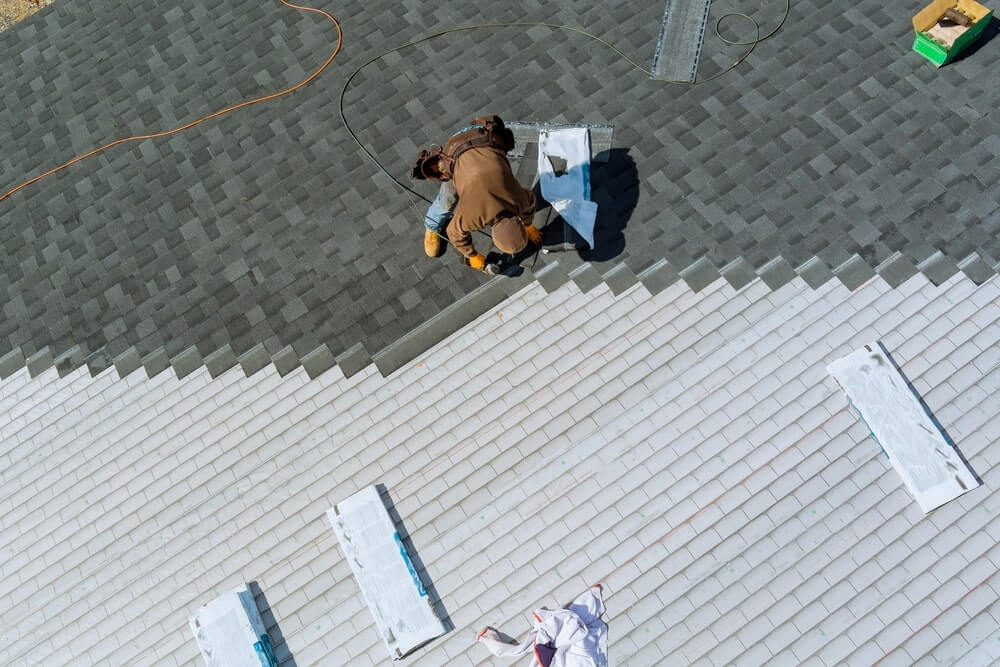Pinnacle Home Improvements’ expertise and experience in installing and maintaining roof tiles is second to none. This is why we are chosen for our roofing services by so many in our community.
We do much more than install new roofs, though. We’re also here to educate you to ensure you’re making a decision you feel comfortable and confident in. With this in mind, let’s dig deeper into the comparison of clay vs. concrete roof tiles.
Clay Roof Tiles vs. Concrete Roof Tiles: An Objective Comparison of Durability and Cost
When contemplating a roofing solution for a home, the material choice is crucial to both aesthetics and durability. Pinnacle Home Improvements stands at the forefront of providing quality roofing solutions, emphasizing both longevity and style. These materials are prized for their resistance to fire, ability to withstand harsh weather conditions, and their contribution to energy efficiency in a home.
Clay roof tiles are known for their classic appeal and longevity. The natural properties of clay allow for a diverse range of colors and textures, which can create a unique look for any home. They have been used for centuries, a testament to their durability and enduring appeal. Conversely, concrete roof tiles offer versatility and cost-effectiveness. They can mimic the appearance of clay, wood, and slate, providing homeowners with affordable alternatives that do not compromise on the aesthetic front.
Selecting between clay and concrete roof tiles hinges on an array of factors including budget, climate, structural requirements, and personal taste. Pinnacle Home Improvements acknowledges the importance of these considerations and is committed to guiding homeowners through the process, ensuring a choice that aligns with their needs and preferences. The company’s approach is centered around informed decision-making, providing customers with all the information necessary to make the best investment for their home.
Benefits of Clay Roof Tiles
Clay roof tiles offer a harmonious blend of practicality and visual charm, aligning with both modern and traditional architecture.
Aesthetic Appeal
Clay roof tiles provide a distinctive beauty; their natural color, which can range from terracotta to earthy tones, does not fade over time due to the inherent colorfast properties of the material. They can present a variety of shapes and finishes that cater to a diverse range of architectural styles. The natural texture of clay adds depth and character to roofs, enhancing curb appeal.
Historical Significance
Clay tiles carry historical significance, having been used for centuries across various cultures. Their use in buildings is often associated with heritage and tradition. Preservation of historical integrity is one reason many restoration projects and period-style new builds opt for clay roof tiles, ensuring the architectural continuity of the area.
Advantages of Concrete Roof Tiles
Concrete roof tiles present a robust option for roofing, with their enduring nature and economic benefits standing out as their primary advantages.
Cost Efficiency
Concrete roof tiles are a cost-effective solution for homeowners seeking long-term value. Initially, the cost of concrete tiles is often lower than clay alternatives, making them a more budget-friendly option upfront. In addition to their affordability, they have a proven track record for longevity, often lasting for 50 years or more, which can significantly reduce the lifetime cost of a roof.
- Lower Initial Expense: Concrete tiles are generally more affordable per square foot compared to other roofing materials, such as clay.
- Reduced Lifetime Cost: Due to their durability, the need for replacements or repairs over the roof’s lifespan tends to be less frequent, which can lead to cost savings over time.
Versatility
The versatility of concrete roof tiles encompasses a broad spectrum of styles and colors, enabling a perfect complement to a variety of architectural designs. Concrete tiles can be made to mimic the appearance of other materials, such as slate, wood shakes, or even clay tiles, without compromising on the functional benefits.
- Wide Range of Styles: Homeowners can choose from flat to barrel-shaped tiles and a variety of finishes resembling other roofing materials.
- Color Options: Concrete tiles offer a vast palette of colors, which are achieved by adding dyes during the manufacturing process or applying surface treatments.
Incorporating elements of durability, concrete roof tiles are composed of a mixture of cement, sand, and water, which cures to form a hard-wearing material. They exceed in resisting harsh weather conditions, including heavy rains, high winds, and hail, making them a protective barrier against the elements. Not only is the material tough, but it’s also low maintenance, resistant to rot, and not vulnerable to pest infestations.
- Weather Resistance: Engineered to withstand various climatic challenges, increasing their suitability for diverse regions.
- Low Maintenance: The inherent strength of concrete minimizes the need for frequent upkeep, unlike other less durable materials.
Material Analysis and Comparison
Clay and concrete roof tiles have distinct properties that affect their longevity and resistance to the elements. This section examines both materials in these specific areas to guide homeowners in making an informed decision for their roofing needs.
Longevity
Clay roof tiles are renowned for their durability, often lasting over 100 years in optimal conditions. They generally have a longer lifespan than concrete tiles due to their resistance to color fading and structural deterioration. In contrast, concrete roof tiles have a somewhat shorter lifespan, typically around 50 years. The difference in longevity largely stems from the density and porosity of the materials; clay being less porous typically endures the test of time better.
| Material | Average Lifespan |
| Clay | > 100 years |
| Concrete | ~ 50 years |
Resistance to Elements
Clay tiles perform exceptionally well under various weather conditions. They can withstand high temperatures, UV rays, and even fire, making them a safer choice in fire-prone areas. Due to the method of manufacture and the inherent qualities of the material, clay tiles also resist rot and insect damage.
Concrete tiles are hefty and robust, offering good protection against hail and high winds. However, they are more susceptible to moisture absorption, which can lead to the growth of mildew and moss, and over time this can cause structural degradation. Nonetheless, with proper maintenance and sealing, concrete tiles can resist the elements adequately.
| Material | Fire Resistance | UV Resistance | Rot & Insect Resistance | Hail & Wind Resistance |
| Clay | Excellent | Excellent | Excellent | Good |
| Concrete | Good | Good | Moderate | Excellent |
Selection Guidance
When selecting between clay and concrete roof tiles, homeowners must consider the local climate and the architectural style of their home. These two factors are crucial in ensuring both the longevity of the roof and aesthetic harmony.
Climate Considerations
Clay tiles excel in hot, dry climates as they naturally help to regulate indoor temperatures. They are also highly resistant to decay caused by salt air, making them ideal for coastal regions.
- Hot & Dry Climates:
- Clay Tiles: Superior longevity and heat resistance.
- Concrete Tiles: Good durability but may retain more heat.
- Cold Climates:
- Clay Tiles: May be prone to cracking with freeze-thaw cycles.
- Concrete Tiles: Dense structure offers better frost resistance.
- Wet Climates:
- Clay Tiles: Lower water absorption rates.
- Concrete Tiles: Prone to moss and algae if not properly treated.
- Wind Resistance:
- Both clay and concrete tiles offer good resistance, but installation methods and tile quality can influence performance.
Architectural Compatibility
The appearance of the roof should complement the home’s overall design aesthetic. Expert tips suggest matching tile material to the architectural style for the best result.
- Historic or Traditional Homes:
- Clay Tiles: Known for their classic look and natural color variations.
- Concrete Tiles: Can mimic clay and offer more color and shape options.
- Modern or Contemporary Homes:
- Concrete Tiles: Often a better match due to varied shapes and finishes.
- Clay Tiles: Some modern designs can work well with sleek clay tile lines.
By carefully considering these elements, homeowners can make an informed decision on the appropriate roofing material for their specific situation.
Maintenance Strategies
Maintaining clay and concrete roof tiles effectively extends their lifespan and preserves their aesthetic appeal. Here, we compare maintenance strategies for both materials.
Clay Roof Tiles
- Inspection: Regularly check for cracked or broken tiles.
- Cleaning: Remove moss, algae, or dirt buildup gently with water and a soft brush.
- Re-coating: Optional, apply sealant to enhance durability and color retention.
Concrete Roof Tiles
- Inspection: Just like clay, inspect for damage, paying close attention to efflorescence (white, powdery residue).
- Cleaning: High pressure washing can be used carefully to avoid damage.
- Sealing: Apply sealant to prevent moisture penetration and fading.
General Maintenance Tips
- Safety First: Always prioritize safety; use a secure ladder and consider hiring professionals.
- Immediate Repairs: Address damages quickly to prevent leaks.
- Gutter Cleaning: Ensure gutters are clear to prevent water damage.
Comparative Aspects
- Clay tiles may require more gentle maintenance techniques due to their fragility.
- Concrete tiles, albeit more durable, might demand more frequent sealing due to their porous nature.
Periodic maintenance ensures that either type of roof tiles performs optimally and maintains a pristine appearance. Pinnacle Home Improvements can handle this and any other roof-related task for you.








